Imagine living in a world where 82% of the populace is on a gold rush, yet only 40% actually own a map to the treasure. That’s the current scenario in content marketing.
A significant 82% of marketers recognize the critical role of content marketing in today’s digital economy and are investing accordingly. However, only 40% of B2B marketers possess a documented strategy to steer their efforts. It’s like embarking on a journey into the Amazon Rainforest without a compass—thrilling but potentially dangerous!
Why does this gap exist, and how can you bridge it to gain a competitive advantage? Whether you’re a business striving to stand out in a crowded marketplace or a marketer aiming to master the art and science of content marketing, this ultimate guide to content marketing will be your comprehensive roadmap.
We’ll explore in-depth strategies, examine tactics, and reveal the tools that can propel your content from being overlooked to becoming unmissable.
So, take a deep breath and get ready to dive in. Let’s learn how to do content marketing in the right way!
Table of Contents
What is content marketing?
Content marketing—have you heard the term before? It might sound like just another buzzword vying for your attention, but it’s actually a strategic marketing revolution that’s been stirring up the business world.
If your curiosity is piqued and you’re wondering what exactly content marketing is, let’s dive in.
Content marketing is a strategic approach focused on creating and distributing valuable, relevant, and consistent content to attract and retain a clearly defined audience — and ultimately, to drive profitable customer action.
But here’s the twist: Instead of explicitly promoting your products or services, you’re providing insightful information that empowers your audience to make informed purchasing decisions.
Picture it as a magnetic force that pulls your audience towards your brand, engaging them and transforming them into loyal customers. It’s essentially a magical concoction of content creation, distribution, and audience targeting, proving to be indispensable in our hyper-connected world.

The importance of content marketing
In the world of internet and social media, content marketing reigns supreme.
The era of aggressive sales pitches has been replaced by a new paradigm: building meaningful connections with your audience and offering them tangible value. And this can be done beautifully with Conten Marketing.
Whether it’s brand awareness, customer retention, or lead generation, content marketing is a potent tool in your arsenal.
But, how potent? Let’s dive in.
The ROI of content marketing is very high
Don’t take my word for it. Let’s let the numbers do the talking. According to Demand Metric, Content Marketing costs 62% less than outbound marketing & generates 3x as many leads. That’s right! More leads for less cash. That’s a win-win in any marketer’s book.
Plus, it’s not just about saving money; it’s about making it too. Content marketing also aids in customer retention, which, as we all know, is much more cost-effective than acquiring new customers. So, essentially, content marketing is an investment that keeps giving back.
An unavoidable necessity in today’s digital world
In today’s digital age, content marketing is no longer a luxury; it’s a necessity. Take the example of ‘Glossier,’ a small business that built an empire primarily through savvy content marketing. Their strategy focused on creating engaging, user-centric content, which resonated with their audience and built a loyal customer base.
So, if you’re still on the fence about content marketing, it’s time to hop off and join the game.
The impact of content marketing on the society
Content marketing has a massive influence on our society and culture. It shapes consumer behaviors and builds communities. A perfect example of this is Dove’s ‘Real Beauty’ campaign. This content marketing strategy was more than just selling soap; it challenged societal beauty standards, promoting body positivity and self-love. This campaign resonated with consumers on a deeper level, leading to increased brand loyalty and recognition.
In conclusion, content marketing is not just about creating content; it’s about creating value. It’s a strategic approach that can yield significant business benefits, from lead generation to customer retention. It’s a modern marketing necessity that can shape societal norms and behaviors. So, whether you’re a small business or a large corporation, content marketing should be a key component of your marketing strategy.
Advantages of content marketing
These are some simple yet powerful reasons why content marketing is good for your business.
1. Gain trust and authority
In the digital landscape, trust of the customers is a precious commodity that every marketer dreams to earn. But how can it earn it quickly?
The answer lies in Content marketing. By creating high-quality, valuable content, you position your brand as a trusted authority in your field. It’s like being the go-to expert everyone wants to consult. And who doesn’t want that?
2. Establish thought leadership
Thought leadership might sound like a fancy term, but it’s a crucial part of content marketing. By sharing expert insights, original research, and educational resources, you establish yourself as a leading voice in your industry. This isn’t just about showing off your knowledge – it’s about shaping conversations and driving industry trends.
3. Boost organic web traffic
Good content marketing and SEO go hand in hand. Producing relevant, keyword-rich content can significantly boost your SEO, catapulting your website to the top of search results. The result? More organic web traffic. In fact, companies that blog have 434% more indexed pages than those that don’t. Now that’s a statistic we can’t ignore!
4. Attract and grow site traffic with content promotion
There’s more to content marketing than just creating great content. It’s also about getting it in front of the right eyes.
Through smart promotion strategies, like social media sharing, you can significantly grow your site traffic. Think of it this way: the more people who see your content, the higher your chance of conversions.

5. Enhance lead generation and conversions
Speaking of conversions, did you know that content marketing can serve as a potent lead magnet? That’s right. High-quality content can entice potential customers, leading to increased conversions.
In fact, content marketing rakes in conversion rates six times higher than other methods.
6. Ensure customer loyalty and increase Retention
Content marketing isn’t just about attracting new customers. It’s also about keeping the ones you already have. By consistently delivering valuable content, you encourage customer loyalty and retention. It’s all about building lasting relationships.
7. Boost audience engagement
At the core of successful content marketing is creating content that provides real value. This means answering your audience’s questions, solving their problems, and meeting their needs. When you do this, you boost engagement rates. After all, who wouldn’t want to engage with content that’s useful, relevant, and valuable?
8. Strengthen brand perception
Quality content can do wonders for your brand perception. It can showcase your brand’s expertise, values, and commitment to customers. This can significantly influence how the public perceives your brand. Remember, perception is reality in the eyes of consumers.
9. Educate your audience
Content marketing can also be a powerful tool for educating your target audience. By providing them with the information they need, you make them more likely to engage with your brand.
Plus, an educated audience is a more empowered audience.

10. Cost efficiency
Want to know another great thing about content marketing? It’s cost-effective. It costs 62% less than traditional marketing but generates about three times as many leads. In other words, you’re getting more bang for your marketing buck.
11. Increase customer lifetime value
Content marketing isn’t just about customer acquisition. It’s also about increasing the lifetime value of existing clients. By consistently delivering value through your content, you encourage clients to maintain a long-term relationship with your brand.
Some interesting facts about content marketing
- More marketers are investing in content than ever: Content marketing is undeniably a powerhouse in the digital marketing world. With a whopping 82% of marketers actively investing in this strategy, it’s clear that businesses are harnessing the power of quality content to drive their online presence. But what about the 10% who aren’t leveraging content marketing? Perhaps they’re missing out on a lucrative opportunity, or maybe they’re yet to discover the potential this strategy holds.
- The power of having a documented strategy: A significant 40% of B2B marketers have a documented content marketing strategy. However, when we drill down into the most successful marketers in this category, the number jumps to 64%. This correlation suggests a strong link between a documented strategy and success. So, if you’re a B2B marketer and you’re yet to pen down your strategy, there might be an opportunity to up your game.
- Content Marketing vs. Outbound Marketing: When we pit content marketing against outbound marketing, the former emerges as a clear winner. In fact, content marketing is three times more efficient in terms of lead generation. This is a significant statistic for any business looking to amplify their reach and attract a wider audience.
- Content Marketing in the B2C World: On the B2C front, content marketing is certainly not lagging. About 60% of B2C marketers are using content marketing strategies to engage their audiences and foster brand loyalty. If you’re in the B2C space and you haven’t jumped on the content marketing bandwagon yet, it’s high time you did.
- Investing in Content Creation: In a global perspective, 56% of businesses are planning to increase their investment in content creation. This suggests a growing recognition of the role of quality content in driving engagement and building a strong brand presence.
- Monitoring Content Creation: To further highlight the importance of content marketing, 73% of businesses have an employee dedicated to overseeing content creation. This points to the critical role of content in marketing strategies and the need for consistent, quality output.
- The Impact on Lead Generation: The benefits of content marketing are palpable with a staggering 72% of companies reporting an increase in leads as a result of their content marketing efforts. This is a compelling reason for any business to consider integrating content marketing into their digital marketing strategy.
- Projected Revenue Growth: Content marketing revenue hit 63 billion U.S. dollars in 2022 and is forecasted to reach an impressive 107 billion U.S. dollars by 2026. This growing industry is a testament to the power and potential of content marketing, providing ample opportunities for businesses to capitalize on.
With such compelling stats, it’s no wonder businesses are doubling down on their content strategies. Are you ready to join them?
Comparing Content Marketing to Traditional Marketing Methods
Understanding traditional marketing
Traditional marketing, fondly known in the business world as the “old school” approach, includes strategies like print advertisements in newspapers or magazines, billboards, television commercials, radio ads, and direct mail.
These methods, though tried and tested, often focus on pushing a product or service onto potential customers without considering their individual needs or interests. It’s a one-way communication where the brand talks, and the audience listens.
Embracing content marketing
On the flip side, content marketing is a more modern, customer-centric approach. It involves creating and distributing valuable, relevant, and consistent content to attract and engage a clearly defined audience. It’s all about pulling the audience in with insightful blog posts, engaging social media updates, informative videos, in-depth ebooks, or even entertaining podcasts. The goal isn’t to interrupt, but to interact.
The key differences
- Customer Engagement: Traditional marketing methods often speak at the audience, whereas content marketing speaks with them. Content marketing is a two-way street, encouraging audience interaction and engagement.
- Personalization: Traditional marketing typically takes a one-size-fits-all approach. In contrast, content marketing allows for more personalized, targeted content tailored to the audience’s interests and needs.
- Cost Efficiency: Traditional marketing, especially mediums like TV commercials or billboards, can be quite expensive. Content marketing, particularly digital content, can often be created and distributed at a fraction of the cost.
- Trackability: With modern analytics tools, content marketing allows businesses to track and measure performance in real-time. Traditional marketing, however, often lacks this level of insight.
Content marketing in action: a real-world example
Take, for instance, the content marketing strategy employed by Buffer, a social media management tool.
Instead of relying on expensive TV ads or billboards, Buffer focuses on creating high-quality blog posts, insightful podcasts, and engaging social media content.
Their blog alone attracts over 1.5 million visits every month, according to Ahrefs data.
This strategy not only helps Buffer to establish authority in their niche but also drives significant traffic to their website. More importantly, it allows them to connect and engage with their audience in a meaningful way, something that traditional marketing might struggle to achieve.
In Summary, while traditional marketing isn’t going anywhere, the rise of content marketing has undeniably shifted the marketing landscape. Businesses who harness the power of content marketing can build stronger connections with their audience, increase brand visibility, and ultimately, drive better results.
The key elements of content marketing
Contrary to popular belief, content marketing isn’t just about pumping out blog posts or posting tweets every few minutes. It’s a comprehensive strategy that encompasses several critical components:
- Audience Targeting: It’s essential to know your audience inside out. This knowledge allows you to customize your content to match their interests and requirements.
- Content Creation: Here’s where your creative juices flow. You’re tasked with producing content that your audience will find beneficial. This could be anything from blog posts and videos to infographics—the possibilities are endless!
- Content Distribution: Once your content is ready, it’s time to get it out there. This could be via your website, social media platforms, email newsletters, or other channels.
Crafting a winning content marketing strategy: a step-by-step guide
Now that you have and understanding of content marketing, let’s focus on the backbone of any successful campaign: a well-crafted content marketing strategy. In this section will guide you through a step-by-step process to build a plan that really works.
Step 1: Define your goals and KPIs
Before you write a single word of content, you need to know what you’re aiming to achieve. Are you looking to drive more traffic to your site? Increase conversions? Boost your SEO ranking? Whatever your goal, make sure it’s SMART – Specific, Measurable, Achievable, Relevant, and Timely.
For instance, instead of saying, “I want more site traffic,” you might say, “I want to increase my site traffic by 20% over the next quarter.” This gives you a clear target to aim for and makes it easier to measure your success.
Step 2: Understand your target audience
Who are you writing for? What are their interests, needs, and challenges? The more you understand your audience, the better you can tailor your content to their needs.
Creating buyer personas can be a great way to understand your audience better. Think of these as fictional, generalized representations of your ideal customers. They can be based on demographic information, behavior patterns, motivations, and goals.
Step 3: Build the Marketing Funnel (Buyer’s Journey)
First things first, let’s demystify what a marketing funnel is.
The marketing funnel is a visual representation of the journey a potential customer takes from the moment they first become aware of your brand (the widest part of the funnel) until they convert into a loyal customer (the narrowest part).
Think of it as a roadmap guiding your customers towards making a purchase.
It’s shaped like a funnel (hence the name) because as potential customers move through each stage, some drop off, leaving fewer people at each subsequent stage.
Understanding the marketing funnel is key to creating effective marketing strategies. It allows businesses to tailor their messaging and tactics to target customers at each stage of the journey, increasing the likelihood of conversion and, ultimately, boosting sales.
Here are the three stages of the funnel:
Top of the funnel (TOFU)
So, how do you start filling this funnel? You start with the Top-of-the-Funnel (TOFU) content.
TOFU is all about attracting and educating your potential customers. It’s your first chance to make an impression, so it needs to be informative, engaging, and valuable.
Imagine TOFU content as a friendly handshake or the first chapter of a gripping novel. It’s your chance to pique curiosity and provide solutions to the problems your target audience might be facing.
Formats for TOFU content: Think along the lines of blog posts, videos, and social media posts. They’re easily digestible, shareable, and a great way of driving organic traffic to your website.
Remember, optimizing your TOFU content for search engines can help you cast a wider net in the digital sea of potential customers.
Middle of the funnel (MOFU)
Now, let’s move a step down the funnel to Middle-of-the-Funnel (MOFU) content. This is where the nurturing happens. Your leads have shown an interest, and now it’s time to build trust and deepen that relationship.
MOFU content is like a second date. You’ve made the initial connection, and now it’s time to share more about what makes you unique. This means more in-depth information about your products or services.
Formats for MOFU content: Ebooks, case studies, webinars – these content formats are all effective at this stage. They allow you to provide a deeper insight into your offerings, showing off your expertise and credibility. Don’t forget to include testimonials and success stories – nothing builds trust like hearing from satisfied customers!
Bottom of the funnel (BOFU)
Finally, we’ve reached the Bottom-of-the-Funnel (BOFU). This is the critical stage where leads are converted into customers. It’s time to roll out the red carpet and convince your leads to take the final step.
BOFU content is like a proposal. It’s time to seal the deal and make it official. This means clear calls-to-action and incentives that encourage purchase decisions.
Formats for BOFU content: Product demos, free trials, discounts – these BOFU content formats are your final nudge. They give potential customers a taste of what they can expect, addressing any last-minute objections or concerns. Personalized emails and tailored landing pages can be effective tools to guide your leads towards making that final purchase decision.
Step 4: Allocate budget
As a savvy digital marketer, you know that success doesn’t come by chance. It all starts with a budget. So, how do you go about setting a budget that aligns with your business goals and target audience?
First, you need to allocate funds for your content marketing efforts. This means setting aside a specific amount of money for creating blog posts, social media content, videos, and more. Tools such as SEMrush and Ahrefs can be a great help, but they come with a price tag. You might also need to consider outsourcing content to professional writers or agencies.
Remember, your budget isn’t set in stone. It should be flexible and adjustable based on your results. Do frequent reviews to see where you’re getting the most bang for your buck and adjust accordingly. And don’t forget to track the ROI of your content marketing budget. This is essential for assessing the effectiveness of your strategies.
Step 5: Research: the foundation of engaging content
Once your budget is set, it’s time to dive into research. You need to understand your audience, their needs, and what content they find most engaging. Use tools like Google Keyword Planner and BuzzSumo to identify popular keywords and topics in your industry.
But don’t stop there. Keep an eye on industry trends and what your competitors are doing. What types of content are they producing? How are they engaging with their audience? What can you learn from their strategies? And remember, your audience’s needs and expectations evolve over time, so make sure your research is ongoing.
Step 6: Conduct a Content Audit and Gap Analysis
A content audit involves taking a deep dive into your existing content to assess its performance. Tools like Google Analytics, SEMrush, or BuzzSumo can be invaluable here, allowing you to identify which pieces are performing well and which could use a little TLC.
A Gap Analysis, on the other hand, involves identifying opportunities for new content. Maybe there’s a topic your competitors are covering that you’re not, or perhaps there’s a keyword you could be ranking for with the right content.
Step 7: Create a Content Calendar and Editorial Plan
With your goals defined, your audience understood, and your content audited, it’s time to start planning your content. Tools like CoSchedule, Trello, or Asana can be useful here, helping you to plan and schedule your content production and publication.
Remember, consistency is key in content marketing. Your audience should know when to expect new content from you, so stick to a regular posting schedule.
Step 8: Create high-quality, engaging content
Now comes the fun part – creating the content! Let’s now delve into the art of content production.
Whether you’re writing blog posts, creating videos, or designing infographics, quality is key. Remember, your content isn’t just about conveying information – it’s also about engaging your audience and providing value.
There are three main ways to produce content for your marketing strategy: creation, curation, and repurposing.
Content creation: the art of originality
Creating original content from scratch is the backbone of any content marketing strategy. This could involve writing a blog post on your WordPress site or recording a podcast. The key here is to provide unique, valuable information that can’t be found elsewhere. Remember, originality breeds credibility.
Content curation: the power of sharing
Not all content has to be original. Content curation involves finding and sharing relevant content from other sources. This not only saves you time but also provides your audience with a diverse range of information. Just make sure to credit the original source appropriately.
Content repurposing: reinventing the wheel
Repurposing content involves taking an existing piece of content and transforming it into another format. For instance, you can turn a blog post into an infographic or a podcast episode. This allows you to reach new audiences and maximize the value of your existing content.
Whether you are creating fresh content, curating or repurposing, you must use tools like Grammarly and Hemingway to improve your content’s quality and readability. You must also keep your finger on the pulse of your KPIs and stay flexible with your content production methods.
Step 9: Implement SEO: your highway to visibility
You can craft the most engaging content, but if it’s not optimized for search engines, it’s like a billboard in the desert. Here’s where SEO comes in.
Start by optimizing your content with relevant keywords and meta tags. This will help search engines understand what your content is about and rank it accordingly.
But SEO isn’t just about keywords. Your website’s structure and navigation also matter. A well-structured website enhances the user experience, which in turn improves your SEO.
Quality backlinks can also boost your visibility. Reach out to authoritative websites in your industry and offer to write guest posts. In return, you’ll get a link back to your website, increasing your visibility in search results.
Step 10: Distribute and promote your content
Creating great content is only half the battle – you also need to get it in front of your audience. This is where content distribution comes in.
Consider using tools like Buffer, Hootsuite, or Mailchimp to streamline and automate your content distribution. Remember, different platforms require different approaches, so tailor your distribution strategy to each platform.
Don’t limit yourself to one channel. Your audience is scattered across different platforms, so make sure your content reaches them wherever they are. Experiment with different content formats like videos, infographics, and podcasts.
Tailor your content to each channel to maximize engagement. And don’t forget to measure your performance on each channel to optimize your distribution strategies.
Step 11: Measure, analyze, and optimize
Finally, it’s time to measure your results.
Just like how a GPS guides you to your destination, Key Performance Indicators (KPIs) navigate your content marketing strategy towards success. KPIs are your roadmap in the world of digital marketing. Let’s dive deeper to understand their significance.
Why KPIs matter
KPIs are a clear, quantifiable measure of your content marketing performance. They help you understand how well your content is performing and where you need to tweak your strategies. The right set of KPIs can be the difference between driving in the dark and having a well-lit path to success.
The metrics that matter
Metrics like website traffic, conversion rates, and engagement levels are the pulse of your content marketing efforts.
- Website Traffic: The number of visitors to your website is a clear indicator of how effective your content is at attracting an audience. Use tools like Google Analytics to monitor this metric.
- Conversion Rates: The ultimate goal of any content marketing strategy is to convert visitors into customers. Tracking conversion rates can help you understand how compelling your content really is.
- Engagement Levels: This measures how your audience interacts with your content. Are they liking, sharing, commenting? High engagement indicates your content is resonating with your audience.
Utilizing analytics tools
Data is the fuel that keeps your content marketing engine running, and tools like Google Search Console, Google Analytics and social media insights (i.e. analytics tools) that most social media platform provide) will give you data that will help you understand whether you are hitting your KPIs or not.
- Google Search Console will help you understand how Google is viewing your content.
- Google Analytics helps you understand your audience and how they interact with your content.
- On the other hand, Social Media Insights provide data on how your content performs across various platforms.
Other than these, you can also use other tools like Microsoft Clarity, HubSpot and Moz to get valuable and actionable insights.
Spotting trends and patterns
Once you have reliable data at your fingertips, it’s time to play detective. Look for trends and patterns that reveal what works and what doesn’t. Is there a particular topic that consistently drives traffic? Or a specific type of content that boosts engagement? Use these insights to make data-driven decisions.
Review, report, repeat
The process doesn’t end with analytics. Regularly review your KPIs and report on your campaign’s performance. This allows you to tweak and refine your strategy, keeping it optimized and effective.
Remember, content marketing isn’t a one-size-fits-all solution. It requires constant monitoring, analysis, and adjustment. But with the right KPIs and analytics tools, you’re not just shooting in the dark; you’re armed with a strategic plan and the tools to achieve your goals.
Where content marketing fits in the marketing pipeline
We all know that a well-tuned engine operates at its most efficient when it’s getting the right amount of fuel. The same principle applies to your marketing pipeline.
Your fuel? It’s content marketing.
When applied strategically across the different stages of the buyer’s journey, content marketing can supercharge your marketing pipeline, powering your potential customers from awareness to retention. Let’s break down how this works at each step of the journey.
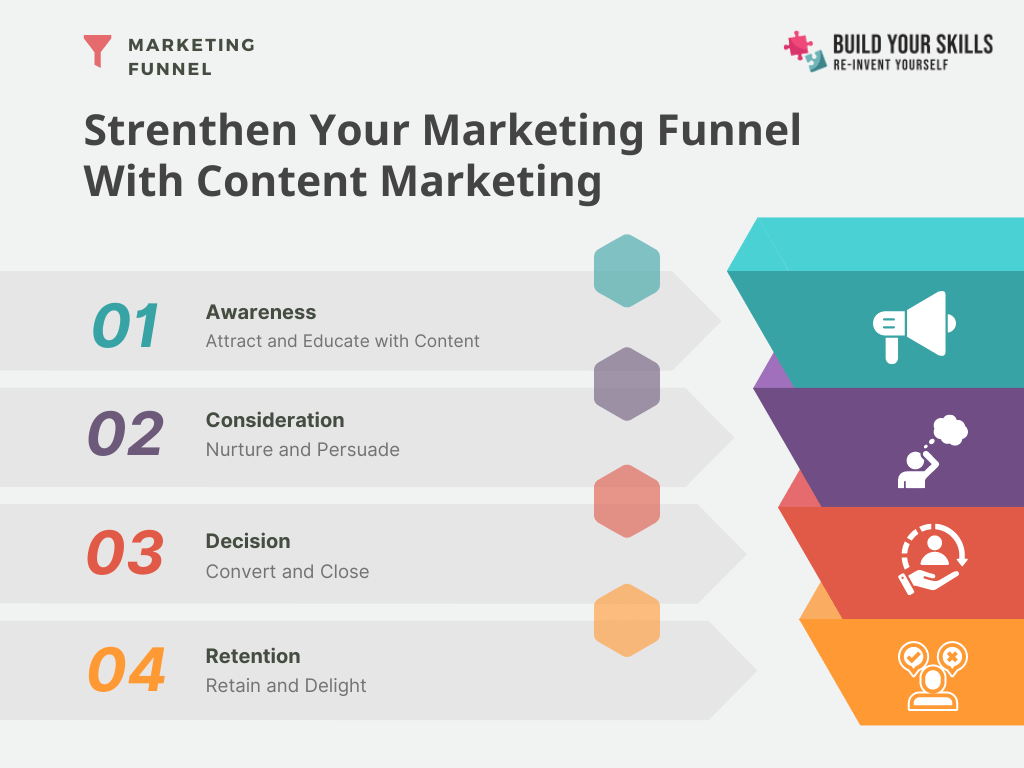
Awareness: attract and educate with content
In the awareness stage, your potential customers are just starting to realize they have a problem or a need. Here, content marketing steps in as a friendly guide, offering valuable information and solutions. Your fuel of choice? Blogs, ebooks, podcasts, videos, infographics, and more. It’s about casting a wide net and pulling them in with engaging, educational content.
According to the Content Marketing Institute, 70% of consumers prefer learning about a company through articles rather than ads. Content at this stage is not about selling; it’s about building trust and establishing yourself as a knowledgeable resource.
Consideration: nurture and persuade
Now that your potential customers are aware of their needs, they’re evaluating their options. This is where your content can help them consider your solution as the best fit. Fuel this stage with webinars, case studies, white papers, testimonials, and more.
For instance, B2B marketers who use case studies see a 70% increase in conversions, according to a recent study by Demand Gen Report. In this stage, your content should provide in-depth information, comparisons, and customer testimonials that persuade the reader to consider your product or service.
Decision: convert and close
At the decision stage, your potential customers are ready to act. Your content here should encourage them to make that final leap. Fuel this stage with product demos, free trials, coupons, discounts, and more.
A Forrester study revealed that product demos are among the top three types of video content influencing purchasing decisions. Offering a free trial or discount can also create a sense of urgency and remove any remaining barriers to purchase.
Retention: retain and delight
Finally, after the purchase, comes the retention stage. Here, content marketing helps you build lasting relationships with your customers. Fuel this stage with newsletters, surveys, feedback forms, loyalty programs, and more.
Adobe found that repeat customers contribute 40% of an average store’s revenue. Your content should now aim to delight and engage your existing customers, encouraging repeat purchases and brand loyalty.
In conclusion, content marketing is not a one-size-fits-all solution; it’s a strategic tool that can be tailored to meet your audience wherever they are in their buyer’s journey. By understanding and applying these principles, you can turn your marketing pipeline into a well-oiled, conversion-generating machine.
Now it’s your turn. Are you ready to fuel your marketing pipeline with strategic content? Let’s get started!
Content types: catering to different tastes of your audience
In the vast ocean of content marketing, there are different types of content that serve different purposes and cater to different audience tastes. Let’s dive in!
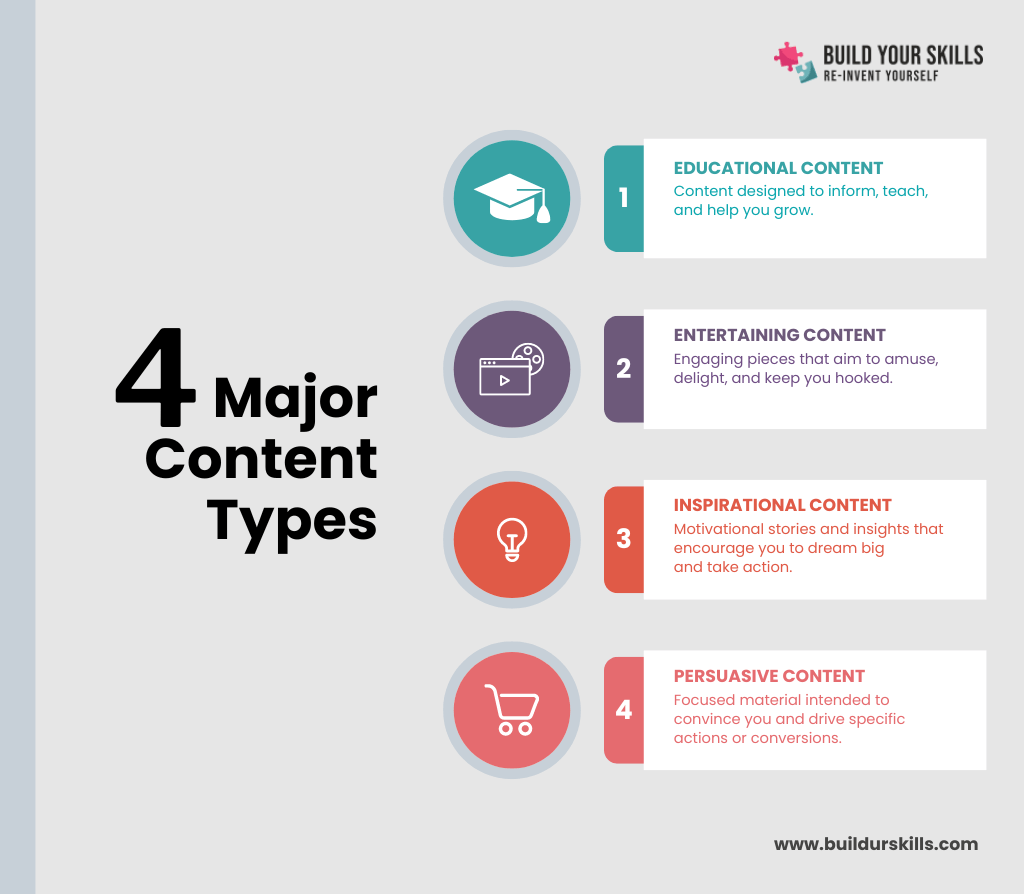
- Firstly, we have Educational Content. This is the kind of content that enriches the knowledge of your audience. Talking about blogs, ebooks, podcasts, videos, infographics, you name it. These are your go-to tools when you’re aiming to inform. Remember when you learned about the new Google algorithm update from a Medium blog? That’s educational content in action!
- Next up, we have Entertaining Content. This is the life of the party! Quizzes, games, memes, gifs – anything that brings a smile to your audience’s face. They’re not just for fun, though. They’re a clever way of engaging your audience and creating a strong brand image. Remember the viral ‘which Disney character are you?’ Instagram filter? That’s entertaining content right there.
- Then, there’s Inspirational Content. This is the heart-warmer, the tear-jerker, the content that motivates your audience. Stories, quotes, testimonials – these are the tools that inspire action. Remember the testimonial you read about a start-up’s journey from zero to hero? You guessed it, that’s inspirational content.
- Lastly, we have Persuasive Content. This is your salesperson in the digital world. Webinars, case studies, white papers – these provide compelling arguments to convince your audience. Remember the last time you attended a webinar and ended up purchasing a course? That’s persuasive content working its magic!
Content formats: the medium is the message
Now that we’ve covered the types of content, let’s talk about the formats. These are the vessels that carry your message to your audience.
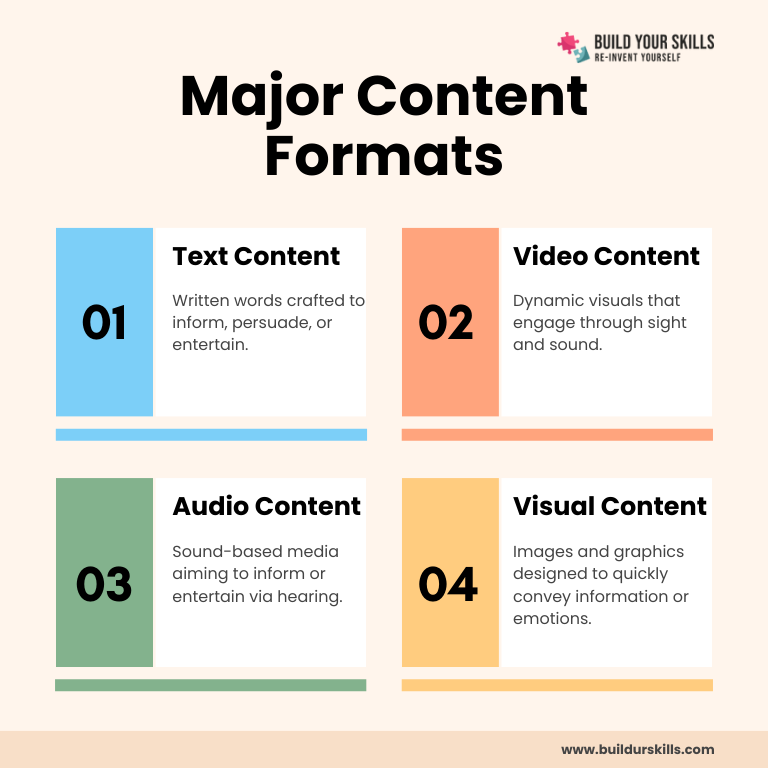
- Textual Content is a classic. From blogs on Medium to ebooks on Kindle and white papers on HubSpot, text is the backbone of content marketing. It’s versatile, searchable, and easy to produce.
- Video Content, on platforms like YouTube and Zoom, is a game-changer. It’s engaging, shareable, and allows for creative storytelling. It’s no surprise that video is predicted to make up 82% of internet traffic by 2022, according to a Cisco study.
- Moving on to Audio Content. Thanks to platforms like Spotify and Audible, audio content such as podcasts and audiobooks is booming. It allows your audience to multitask and adds a personal touch to your content.
- Lastly, Visual Content. Images on Instagram, graphics on Canva, animations on Giphy – these make your content pop! Visuals are processed 60,000 times faster than text, making this format a powerful tool in your content strategy.

The 10 best content formats for marketing
As a seasoned digital marketer with a decade’s experience under my belt, I’ve seen firsthand how the right content strategy can skyrocket your brand’s success. So, let’s dive into the different types of content formats you can utilize to supercharge your strategy.
1. Blog posts
We’re kicking off our list with a tried-and-true content format: blog posts. These bad boys are the backbone of any solid content strategy. Why? They offer a goldmine of benefits: they’re versatile, shareable, and a fantastic way to showcase your industry expertise.
Moreover, blogs are a boon for SEO. Regularly posting fresh, high-quality content on your blog signals to search engines like Google that your site is active and worth ranking. Plus, blogs are a fantastic platform for targeting long-tail keywords, providing another SEO boost.
2. Infographics
Next up, we have infographics – the perfect blend of information and visuals. Infographics are a fantastic way to simplify complex data or concepts. Plus, their visual nature means they’re highly shareable, making them an excellent tool for increasing social shares and driving traffic.
However, remember that infographics require thoughtful planning and design to effectively communicate your message. But when done right, they can serve as powerful link-building and SEO assets.
3. Videos
Now, let’s talk about videos. In the age of YouTube and TikTok, videos have become a must-have in any content strategy. They’re engaging, versatile, and can significantly drive conversions. Whether you’re telling a story, demonstrating a product, or showcasing your service, videos offer a dynamic way to connect with your audience.
Remember, accessibility is key. Including subtitles or closed captions can make your videos more accessible to a wider audience, and search engines love it too.
4. Ebooks
Ebooks are another fantastic content format to consider. They provide a platform to delve deeper into topics, making them an effective tool for establishing thought leadership. Plus, they’re an excellent lead generation tool. Offering an ebook in exchange for an email address is a proven way to grow your subscriber list.
Not to mention, ebooks are incredibly versatile. You can repurpose them into blog posts, webinars, or even social media posts.
5. Case studies and testimonials
Last but certainly not least, we have case studies and testimonials. These serve as powerful trust builders, providing social proof of your product or service’s benefits. By showcasing the success stories of your customers, you humanize your brand and build credibility.
Incorporating case studies and testimonials into your content strategy can lead to increased conversions and customer loyalty. Plus, they can be used across various formats, from blog posts to videos and social media posts.
6. Social media posts
When it comes to reaching a broader audience and driving traffic to your website, social media posts are a goldmine. These bite-sized content pieces should be sharp, engaging, and armed with attention-grabbing headlines. And let’s not forget the power of visuals! High-quality images or videos can be the shiny lure that pulls in potential customers.
To strengthen your brand identity, maintain a consistent voice and tone across all posts. And don’t shy away from experimenting with various formats like infographics. They keep your content fresh and appealing.
Remember, the key to a successful social media strategy is to monitor engagement and track analytics. This allows for constant refinement and improved results over time.
7. Emails
Next up, we have the MVP of content formats – email marketing. It’s one of the most cost-effective and efficient ways to communicate with your audience on a personal level. Whether you’re promoting special offers, sharing news, or delivering valuable content, email marketing is your go-to tool.
And the best part? These campaigns can be automated, saving you a tremendous amount of time and effort. Just remember, the secret sauce of email marketing lies in crafting compelling subject lines and providing value-packed content.
8. Webinars
Webinars are live online events that allow you to share valuable information with your audience in real-time. Whether you’re educating, entertaining, or promoting, webinars can be a powerful tool in your content arsenal.
Not only are they easy to set up, but they can also be recorded for later use. Plus, the live interaction they offer can significantly boost audience interest and participation.
What’s more, webinars can be an effective lead generation tool and a fantastic way to build your email list.
9. Podcasts
Podcasts are a versatile and engaging content format that can reach a wide audience. For those who prefer audio content or are always on the go, podcasts allow for easy consumption of information.
This format gives your brand a voice, allowing you to showcase your brand’s personality and expertise. You can also repurpose your podcasts into blog posts or social media content, further extending their reach.
Do remember, a successful podcast is well-produced, features quality guests, and delivers valuable insights.
10. Paid Ads
Last but not least, paid ads can help enhance your brand’s visibility and reach a wider audience. With the ability to target specific demographics, interests, and locations, paid ads can be a cost-effective way to drive traffic.
Ad formats range from display ads to video ads, depending on your goals. And always remember, it’s essential to measure the performance of your paid ads to optimize your return on investment.
Content strategies: playing the long game
Finally, let’s talk strategy. Depending on your goals, you might opt for different content strategies.
- Long-form Content, like ebooks on Kindle or white papers on HubSpot, is perfect for in-depth exploration of a subject. It’s great for SEO and positions you as an expert in your field.
- On the other hand, Short-form Content, like blogs on Medium or infographics on Piktochart, delivers quick, digestible information. It’s ideal for generating social shares and engaging your audience.
- Evergreen Content, like how-to guides on WikiHow or FAQs on Quora, is timeless. It continues to drive traffic long after it’s published, giving you more bang for your buck.
- Last but not least, Seasonal Content, like holiday campaigns from Coca-Cola or newsjacking from Oreo, rides the wave of current events. It’s timely, topical and generates buzz.
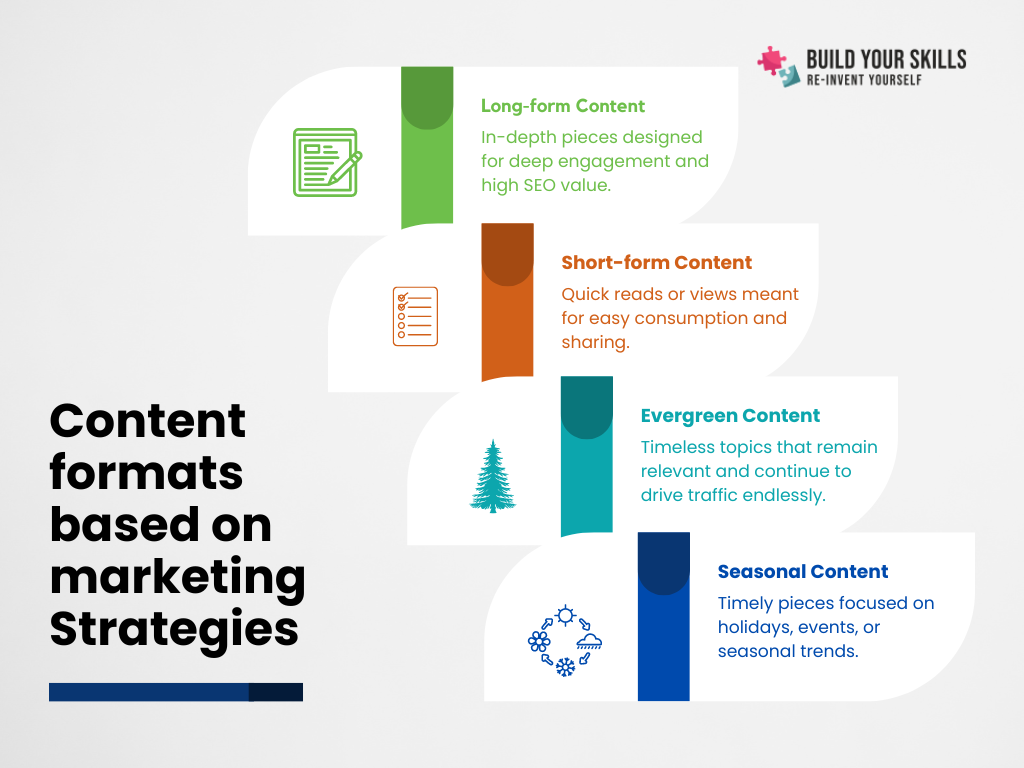
Crafting the right mix of content types, formats, and strategies is a complex task, but when done right, it can work wonders for your brand. So, ready to start creating?
Some incredibly successful content marketing campaigns
Here are some remarkable content marketing campaigns that nailed their strategy and delivered outstanding results.
1. Spotify Wrapped: a personalized listening experience
The end of the year isn’t just for holiday cheer, but also for Spotify Wrapped, a custom-made campaign that adds a personal touch to your music listening journey. This campaign creates tailored playlists and graphics for each Spotify user, reflecting their unique listening habits and preferences.
The genius part? It encourages users to share their results on social media platforms, creating a viral buzz.
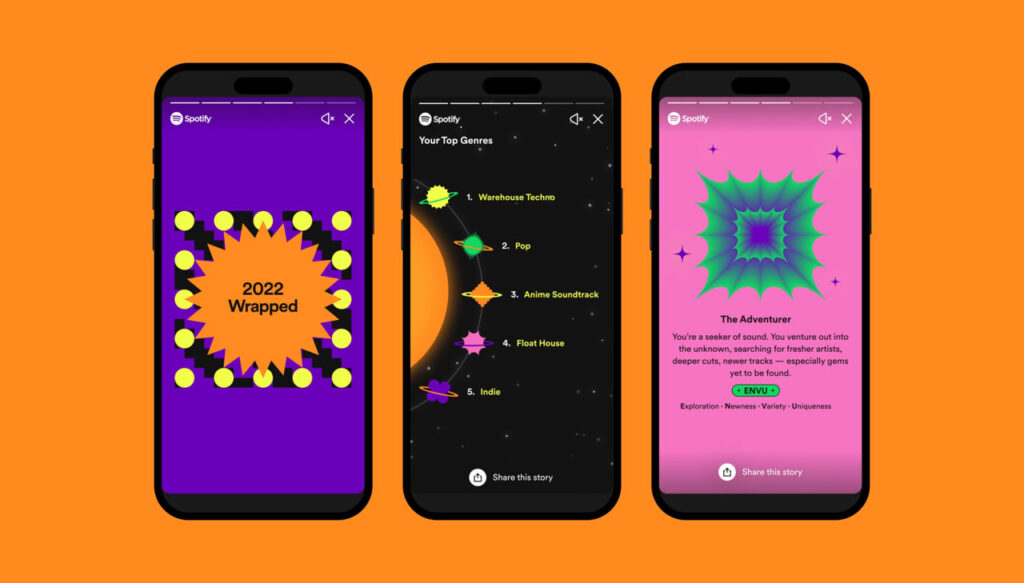
2. DuoLingo’s TikTok: a hoot of humor
Learning a new language can be fun, and Duolingo’s TikTok campaign proves just that. Featuring the app’s green owl mascot in a variety of hilarious scenarios, the campaign cleverly avoids direct promotion. Instead, it focuses on showcasing the app’s personality and humor, garnering millions of followers and potential customers.
3. Canva Design School: empowering creativity
For those looking to upskill in the world of design, Canva Design School is a go-to. Offering free online courses on graphic design and media marketing, this campaign is both educational and interactive. It not only elevates Canva as a leader and authority in the design space, but also imparts valuable skills to its users.

4. L’Oréal Paris Signature Faces: Augmented Reality in beauty
L’Oréal Paris Signature Faces campaign brings the makeup trial experience right into users’ homes. Using augmented reality filters, users can experiment with different makeup looks on popular video conferencing and social media platforms. It’s a fun, convenient, and innovative way to try before you buy.
5. IKEA Get the look #BernieSanders: creativity meets virality
IKEA’s Get the look #BernieSanders campaign is a testament to the power of viral moments. Capitalizing on the famous image of Senator Bernie Sanders at the US presidential inauguration, IKEA recreated his cozy outfit using their products, right from chairs and rugs to gloves. It’s a fun, engaging, and relevant way to showcase IKEA’s creativity.
6. Stranger Things by Netflix: engaging fandom
Netflix’s Stranger Things is more than just a popular sci-fi horror series. It’s a content marketing goldmine, creating a loyal fan base with its immersive and nostalgic content. The show has launched various campaigns, including interactive games, brand partnerships, and behind-the-scenes content to keep the fans hooked.
7. Airbnb’s Online Experiences: from home to the world
The pandemic didn’t stop Airbnb from offering unique experiences to its customers. With their Online Experiences campaign, users can book activities hosted by local experts from around the world, all from the comfort of their homes. From cooking, yoga, to art, there’s something for everyone. It’s a testament to Airbnb’s adaptability and commitment to providing value and entertainment.
8. HubSpot’s Content Marketing Certification Course: knowledge is power
Last but not least, HubSpot’s Content Marketing Certification Course proves that knowledge is power. Offering a free online course on content marketing, it covers topics such as content strategy, creation, distribution, and analysis. This campaign not only establishes HubSpot as a leader in the content marketing space but also imparts valuable skills to its customers.
These campaigns are shining examples of how brands can creatively engage with their audience. They’re informative, engaging, and most importantly, they add value to the customers’ lives. As you plan your next campaign, consider incorporating some of these elements to take your content marketing to the next level.
The past, present, and future of content marketing
Now let’s take a step back in time to explore how content marketing evolved into the powerful tool it is today.
The Pre-Digital Era: content marketing’s humble beginnings
Believe it or not, content marketing has been around way before the advent of the digital age. In its earliest forms, it existed as customer magazines and newsletters. For instance, think of Benjamin Franklin’s Poor Richard’s Almanack in the 18th century. Not only was it a valuable source of wit and wisdom, but it also served as an ingenious marketing tool for Franklin’s printing business.

Fast forward to the late 19th century, agricultural equipment manufacturer, John Deere, launched The Furrow magazine. It wasn’t just about tractors and plows. Instead, it offered advice on how farmers could increase profitability – a clever way to build trust and rapport with their target audience.
And who can forget the iconic Michelin Guide? In the early 20th century, the tire company began publishing travel guides to encourage road travel, subtly boosting their tire sales.
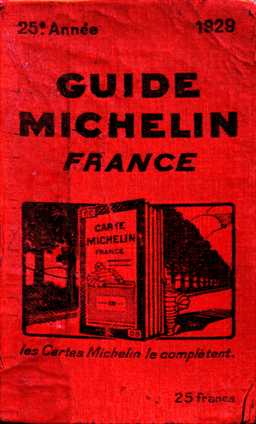
With the rise of mass media in the 20th century, advertising found new avenues like radio, television, and print. Content marketing was evolving, but the digital revolution was yet to come.
Transition to the Digital Age: rise of the internet
As we moved into the late 20th and early 21st centuries, the world witnessed the emergence of digital media and the internet. Websites, blogs, and social media platforms became the new frontier for content marketing.
Content took on a new form with blogs and eBooks gaining popularity. Brands could now directly connect with consumers, offering valuable content that built relationships far stronger than traditional advertising ever could.
A significant milestone was the launch of WordPress in 2003. This platform democratized blogging, opening up opportunities for brands big and small to use this form of content marketing.
Current Trends: personalization, interactivity, and AI
Today, content marketing is about much more than just blogs and eBooks. It’s about personalization, interactivity, and even artificial intelligence.
The rise of video content, for example, has been nothing short of explosive. According to a report by Wyzowl, 91% of businesses now use video as a marketing tool, indicating the rapid growth of this trend.

In addition, AI is increasingly being used to create personalized content experiences, predict user behavior, and even automate content creation.
So, what’s next for content marketing? Well, that’s a story yet to be written. One thing’s for certain though – it will continue to evolve alongside technology and consumer behavior, and we at buildurskills.com will be here to help you navigate it.
With a decade-long experience in Digital Marketing and as the CEO of a leading digital marketing agency, I’ve seen the evolution of content marketing firsthand. The journey has just begun and we are here to help you adapt and thrive in this ever-changing landscape.
Future trends in content marketing
Riding the Voice Search wave
With an increasing number of people finding Siri, Alexa, and Google Assistant as their new best friends, the world of content marketing is shifting towards voice search. If you recall the Jetsons’ cartoon from our childhood, this futuristic technology is no longer a fantasy. According to ComScore, 50% of all searches will be voice searches by 2022.
So, how can content marketers stay ahead? Start by integrating natural language and long-tail keywords into your content. Tools like Answer The Public can provide insights on the questions people are asking, helping you adopt a conversational tone to match. Remember, Hemingway didn’t write in Google keywords, and neither should your voice search strategy.

The rise of Video Marketing
Blink twice, and you’ll miss the latest TikTok dance challenge. The meteoric rise of video platforms like YouTube, TikTok, and Instagram Reels is hard to ignore. By 2022, online videos will make up more than 82% of all consumer internet traffic, according to Cisco.
This provides a golden opportunity for content marketers to tap into. Using tools like Lumen5, InVideo, or Animoto, you can create engaging, informative, and even hilarious video content that could go viral. Remember, the aim is to entertain as much as it is to inform. So, feel free to let loose and let your creativity flow.
Interactive Content: the new buzzword
Remember those ‘Choose Your Own Adventure’ books from the 80s? Well, interactive content is like that, but on steroids. It’s a powerful tool that engages users on a whole new level. According to Demand Gen Report, interactive content generates conversions moderately or very well 70% of the time, compared to just 36% for passive content.
To jump on this trend, consider using tools like Outgrow, Typeform, or Ceros. Whether it’s quizzes, surveys, or interactive infographics, the key is to make your audience feel involved. After all, who doesn’t love a good quiz?
Trust in user-generated content
Word-of-mouth has always been a powerful marketing tool. But in the digital age, this takes the form of user-generated content (UGC). From Yelp reviews to TripAdvisor ratings, UGC is authenticity in its rawest form. In fact, 85% of consumers find UGC more influential than brand content, according to Reevoo.
Embrace this trend by encouraging customers to share their experiences. You can use platforms like Yelp, TripAdvisor, or Trustpilot to gather and promote this content. Remember, authenticity is key, and nothing speaks louder than the voice of a satisfied customer.
Now, isn’t this a fascinating time to be a content marketer?
A timeline of content marketing
Here are some key milestones in the history of content marketing:
- In 1732, Benjamin Franklin published the first edition of Poor Richard’s Almanack, a yearly publication that contained useful information, proverbs, and predictions. He used it to promote his printing business.
- In 1895, John Deere launched The Furrow, a magazine that provided farmers with practical advice on how to improve their crops and livestock. It is considered one of the earliest examples of content marketing .
- In 1900, Michelin published the first edition of The Michelin Guide, a travel guide that offered tips on where to eat, sleep, and repair tires. It was designed to encourage more people to travel by car and use Michelin tires .
- In 1904, Jell-O salesmen distributed free recipe books that featured Jell-O as an ingredient in various dishes. This helped to increase the demand for the product and boost sales.
- In 1982, Hasbro and Marvel Comics collaborated to create a comic book series based on the G.I. Joe toy line. The comics were used to introduce new characters and products and generate interest among children.
- In 1996, John F. Oppedahl, a newspaper journalist, coined the term “content marketing” at a conference of the American Society of Newspaper Editors.
- In 2001, Seth Godin published Permission Marketing, a book that advocated for creating content that people want to receive rather than interrupting them with unwanted ads.
- In 2004, Google launched Google AdSense, a program that allowed publishers to display targeted ads on their websites and earn revenue from clicks.
- In 2006, HubSpot coined the term “Inbound Marketing” to describe a methodology that focused on attracting customers through relevant and helpful content rather than pushing products or services 5.
- In 2010, Joe Pulizzi and Ann Handley founded the Content Marketing Institute (CMI), an organization that provides education, research, and events for content marketers.
- In 2011, Coca-Cola released its Content 2020 Strategy, a document that outlined its vision for creating engaging and shareable content across different platforms and channels .
- In 2013, Netflix launched House of Cards, its first original series produced exclusively for its streaming service. The show was based on data analysis of user preferences and behavior .
- In 2015, Red Bull Media House produced The Fourth Phase, a documentary film that followed snowboarder Travis Rice on his epic journey around the world. The film was part of Red Bull’s content strategy to position itself as an extreme sports and lifestyle brand .
- In 2017, Airbnb launched Airbnb Magazine, a print publication that featured stories and tips from hosts and travelers around the world. The magazine was aimed at inspiring people to explore new destinations and cultures .
- In 2018, Spotify launched its Spotlight feature, which combined audio content with visual elements such as photos, videos, and text. The feature was used to showcase original podcasts, news, and music stories from various partners.
- In 2019, Nike created a series of interactive audio-guided runs on its Nike Run Club app, featuring celebrities and athletes such as Kevin Hart, Mo Farah, and Headspace co-founder Andy Puddicombe. The series aimed to motivate and entertain runners of all levels.
- In 2020, LEGO launched LEGO VIDIYO, a platform that allowed users to create and share music videos using LEGO minifigures and augmented reality. The platform was developed in partnership with Universal Music Group and offered access to a library of songs from various artists.
- In 2021, Mastercard released its first-ever sonic brand identity, a distinctive melody that played across its touchpoints, such as commercials, websites, and point-of-sale terminals. The melody was designed to evoke trust, security, and optimism among consumers .
- In 2022, Netflix partnered with Headspace to produce a four-part series called Headspace Guide to Meditation, which taught viewers the basics of meditation and mindfulness through animated stories and guided exercises. The series was hosted by Headspace co-founder Andy Puddicombe .
These are just some of the examples of how brands have used content marketing to create value for their audiences and achieve their business goals. Content marketing is constantly evolving as new technologies and platforms emerge. As content marketers, we need to stay updated on the latest trends and best practices to deliver relevant and engaging content that meets the needs and expectations of our customers.
The essential roles in a content marketing team
Executing a successful content marketing campaign is no one-man show. It requires a dedicated team of skilled professionals, each playing their part in a symphony of creativity, strategy, and technical expertise.
1. Content Strategist
Like a skilled conductor, the Content Strategist orchestrates the content marketing campaign. They lay out the blueprint, defining the goals, audience, tone, style, and format of the content. With meticulous research and analysis, they create the content plan and calendar, and closely oversee the production and distribution of content. But their role doesn’t stop there. They’re also responsible for measuring the results and optimizing the strategy.
2. SEO Strategist
The SEO Strategist is the master of visibility. They work tirelessly behind the scenes to optimize the content for search engines, ensuring that your valuable content gets seen by the right audience.
3. Content Creators
Content Creators are the heart and soul of any content marketing team. They are the artists and storytellers, crafting original and engaging content tailored for specific channels and audience segments. This diverse group includes Content Writers, who produce everything from articles and blog posts to whitepapers; Videographers, who create compelling videos for platforms like YouTube or social media; and Photographers, capturing high-quality images that bring articles and social posts to life.
4. Editors
Editors are the gatekeepers of quality, consistency, and relevance. They scrutinize the content, ensuring every word, image, and video aligns with the strategy and resonates with the audience.
5. Social Media Manager
The Social Media Manager is the public face of your brand, promoting content across various social media platforms with a keen understanding of each platform’s unique audience and etiquette.
6. Content Distributors/Marketers
Content Distributors are the messengers, making sure your content reaches the four corners of the digital world. They distribute the content across multiple channels for maximum reach and engagement.
7. Project Managers
Project Managers are the backbone of the operation. They oversee the timeline, resources, and execution of the content marketing project, keeping everyone on track and the project on schedule.

8. Graphic Designers
Graphic Designers add the finishing touches, enhancing the content’s visual elements to align with the brand identity. Their contribution can turn a good post into a visually stunning one.
9. Data Analysts
Data Analysts are the numbers gurus. They monitor performance metrics, providing vital insights that can shape strategy optimization.
10. Community Managers
Community Managers are the voice of the audience within your team. They manage community interactions, gather feedback, and ensure your audience feels heard and engaged.
11. UX/UI Designers
UX/UI Designers are the architects of user experience. They ensure the content provides an optimal user experience, making it easy for your audience to interact with your content and take desired actions.
12. Technical SEO Experts
Technical SEO Experts are the mechanics of your website. They work on the technical aspects of SEO, such as site speed and schema, ensuring your site is in tip-top shape for both users and search engines.
13. Copywriters
Copywriters are the persuaders. They specialize in writing copy that drives actions – whether that’s clicks, shares, or conversions.
14. Content Curators
Content Curators are the collectors, gathering and presenting external content that aligns with the overall content strategy, adding diversity and depth to your content pool.
15. Legal and Compliance Teams
Last but not least, the Legal and Compliance Teams ensure all content meets regulatory and legal standards, keeping your content marketing campaign above board and out of hot water.
How to become a content marketing expert
Becoming a content marketing expert can turbocharge your career or business, opening doors to new opportunities and growth.
Learning the ropes
To start your journey, you need to master the fundamentals of content marketing. Fortunately, a wealth of resources exists to help you learn the ropes. Reputable sources such as the Content Marketing Institute and HubSpot Academy offer in-depth courses. Neil Patel’s Blog is another goldmine of practical advice and proven strategies. From writing compelling copy to mastering SEO, these resources can equip you with the knowledge to excel in content marketing.
Practice makes perfect
Like any skill, content marketing gets better with practice. Start by creating your own content – write blogs, design infographics, or record podcasts. If you’re employed, volunteer for content-related projects. This hands-on experience will not only enhance your skills but also give you practical insights into what works and what doesn’t.

Networking for success
Networking is crucial to your growth as a content marketing expert. Join online communities and forums, attend industry events, and connect with other content marketers. This will expose you to diverse perspectives and ideas, and could even lead to valuable collaborations or opportunities.
Stay ahead of the curve
Content marketing is a dynamic field, with new trends emerging constantly. To stay relevant, you must keep abreast of the latest developments. Subscribe to industry newsletters, follow thought leaders on social media, and participate in webinars. Always be learning.
Showcase your talent
A portfolio is a powerful tool to showcase your skills and achievements. Create a professional website or use your social media profiles to display your work. Include case studies, testimonials, and statistics to demonstrate your success. A well-crafted portfolio can be your ticket to attracting clients or employers.

Get inspired by the success stories
Take inspiration from successful content marketers who have risen to the top of their field. For instance, Joe Pulizzi, the founder of Content Marketing Institute, started with a simple blog and built a global community of content marketers. His journey underlines the power of quality content and a strategic approach.
Always remember that becoming a content marketing expert is a journey, not a destination. It requires continuous learning, practice, networking, and innovation. But the rewards – career growth, personal satisfaction, and the opportunity to influence and engage with audiences – make it a journey worth taking.
So, are you ready to embark on your content marketing adventure? Remember, the first step is often the hardest. But once you take it, there’s no looking back. Get started today, and watch your career soar!
Frequently asked questions
What is content marketing
Content marketing is a strategic approach to providing valuable and relevant content to attract and retain audiences. It includes various forms of media like blog posts, videos, and social media. The goal is to drive profitable customer action by understanding the target audience and delivering valuable information.
Why content marketing is important?
Content marketing is crucial for building brand awareness, establishing thought leadership, driving traffic, and improving search engine rankings. Engaging and educating your audience through quality content can lead to increased customer loyalty. Effective content marketing generates leads and boosts sales.
How can I create a successful content marketing strategy?
To create a successful content marketing strategy, start by understanding your target audience’s pain points. Develop a plan that aligns with your business goals and addresses their needs. Optimize your content for SEO using keyword research to increase visibility. Continuously analyze and refine based on performance metrics and audience feedback.
What are some effective ways to distribute and promote my content?
Utilize social media platforms to share your content and engage with your audience. Reach out to industry influencers and ask them to share your content with their followers. Guest post on relevant websites or blogs to reach a wider audience. Use email marketing campaigns to promote your content directly to subscribers.
How do I measure the success of my content marketing efforts?
To measure the success of your content marketing efforts, start by setting clear goals and objectives. Track metrics like website traffic, engagement rates, and conversions to gauge performance. Use analytics tools for data-driven insights and adjust your content strategy accordingly.
Your next steps in mastering content marketing
Ready to dip your toes into content marketing? It might seem daunting, but with the right approach, it can transform your online presence. Start by reading the other articles in this content marketing series on buildurskills.com. You can start with Content Writing: A Definitive Guide.
Remember, content marketing is a journey, not a destination. Keep learning, experimenting, and adapting—there’s a whole world of digital marketing out there waiting for you to conquer.

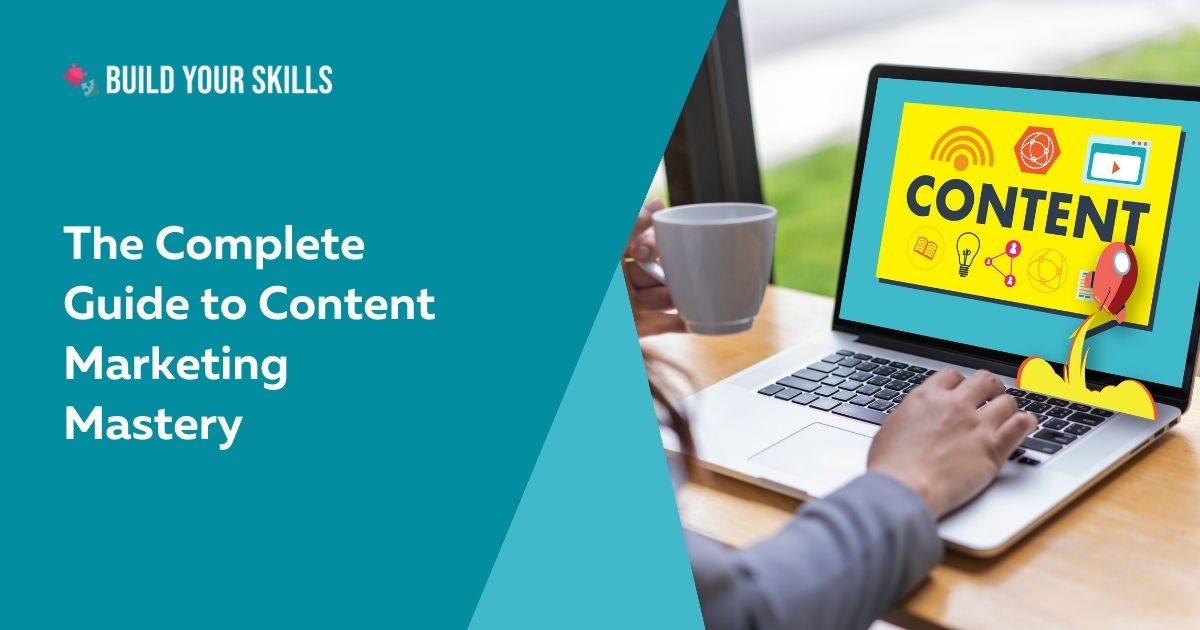
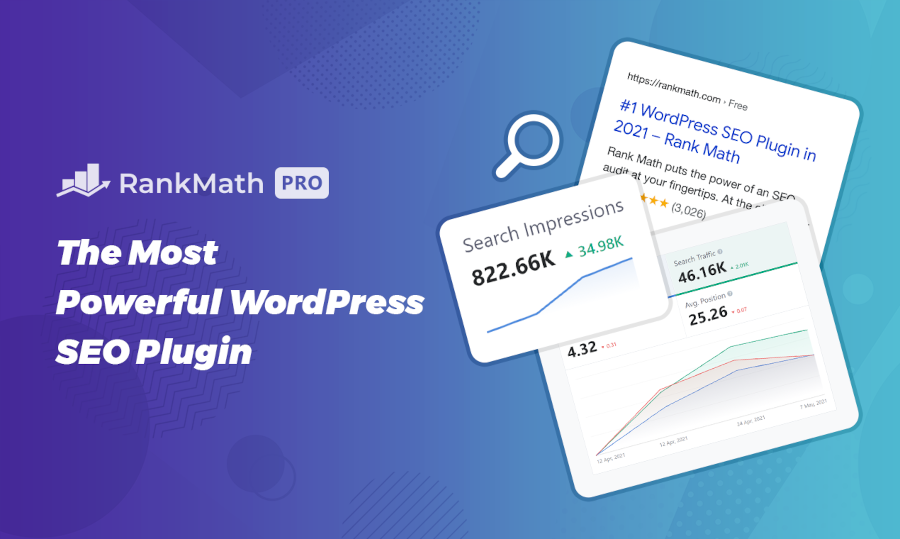

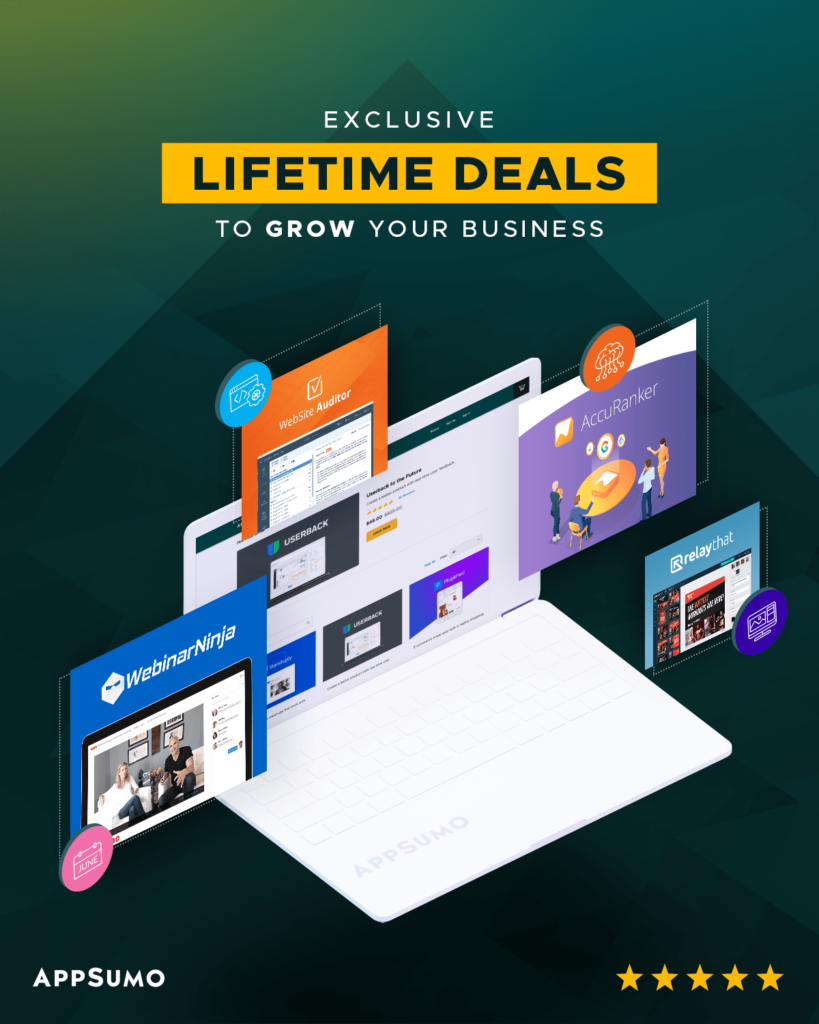
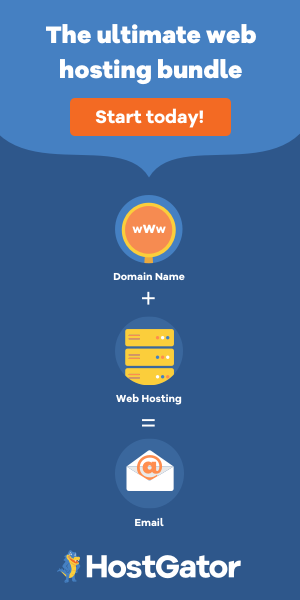
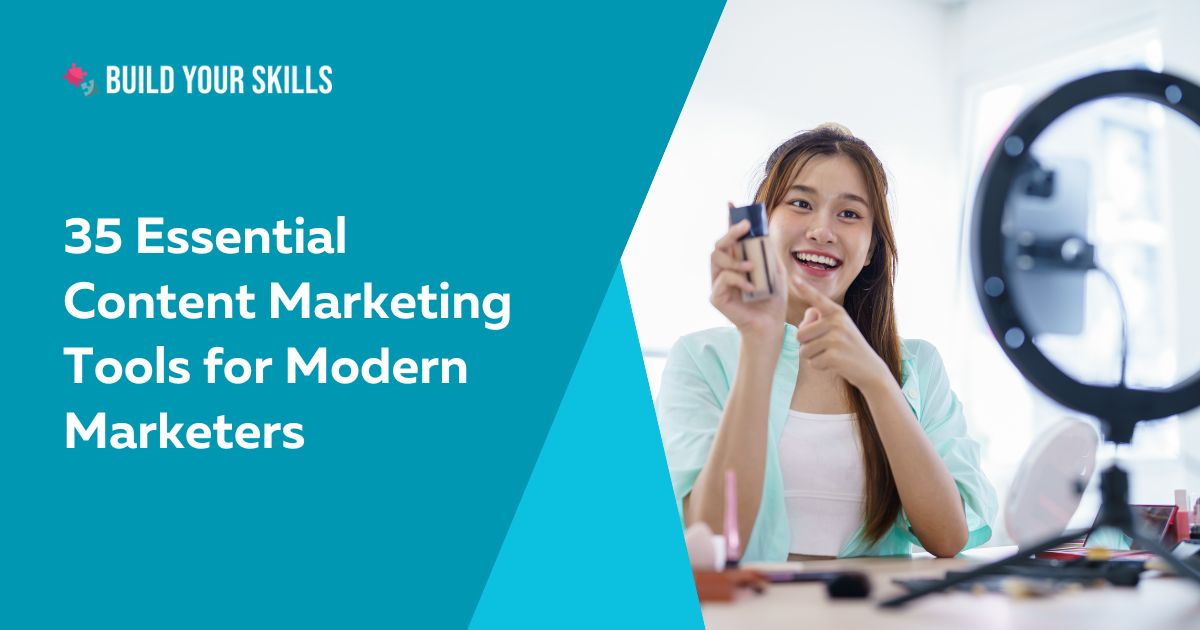

Leave a Reply